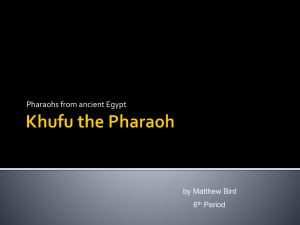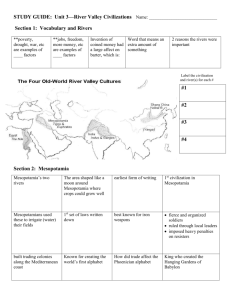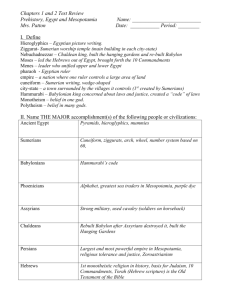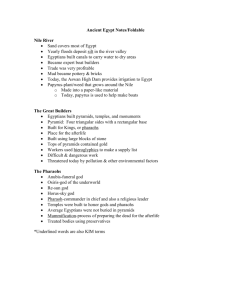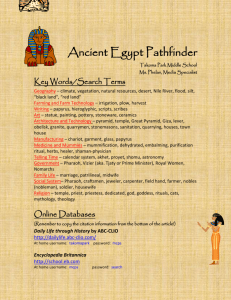EARLY STATES
advertisement
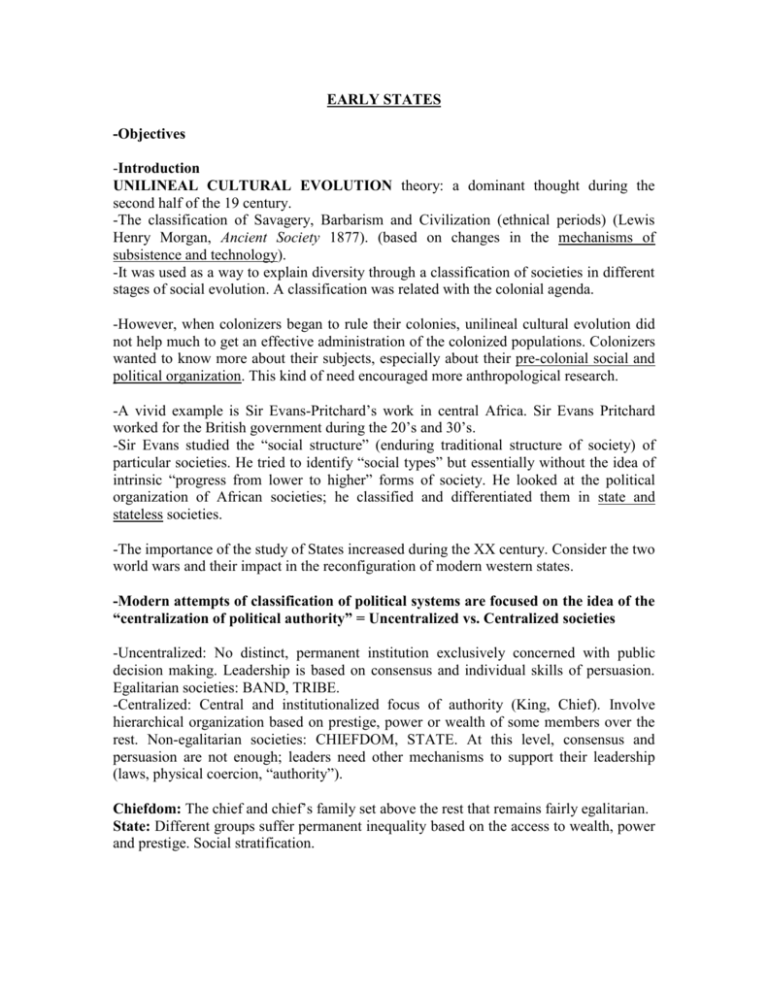
EARLY STATES -Objectives -Introduction UNILINEAL CULTURAL EVOLUTION theory: a dominant thought during the second half of the 19 century. -The classification of Savagery, Barbarism and Civilization (ethnical periods) (Lewis Henry Morgan, Ancient Society 1877). (based on changes in the mechanisms of subsistence and technology). -It was used as a way to explain diversity through a classification of societies in different stages of social evolution. A classification was related with the colonial agenda. -However, when colonizers began to rule their colonies, unilineal cultural evolution did not help much to get an effective administration of the colonized populations. Colonizers wanted to know more about their subjects, especially about their pre-colonial social and political organization. This kind of need encouraged more anthropological research. -A vivid example is Sir Evans-Pritchard’s work in central Africa. Sir Evans Pritchard worked for the British government during the 20’s and 30’s. -Sir Evans studied the “social structure” (enduring traditional structure of society) of particular societies. He tried to identify “social types” but essentially without the idea of intrinsic “progress from lower to higher” forms of society. He looked at the political organization of African societies; he classified and differentiated them in state and stateless societies. -The importance of the study of States increased during the XX century. Consider the two world wars and their impact in the reconfiguration of modern western states. -Modern attempts of classification of political systems are focused on the idea of the “centralization of political authority” = Uncentralized vs. Centralized societies -Uncentralized: No distinct, permanent institution exclusively concerned with public decision making. Leadership is based on consensus and individual skills of persuasion. Egalitarian societies: BAND, TRIBE. -Centralized: Central and institutionalized focus of authority (King, Chief). Involve hierarchical organization based on prestige, power or wealth of some members over the rest. Non-egalitarian societies: CHIEFDOM, STATE. At this level, consensus and persuasion are not enough; leaders need other mechanisms to support their leadership (laws, physical coercion, “authority”). Chiefdom: The chief and chief’s family set above the rest that remains fairly egalitarian. State: Different groups suffer permanent inequality based on the access to wealth, power and prestige. Social stratification. How do we perceive the “State” in the United States? List of General Characteristics of the States: (that are more common to many historical and modern cases). -States have GOVERNMENTS: Hierarchical organization. In ancient states political power was usually inherited (not by personal skill and experience). Consensual methods of decision making are no longer effective. -States create LAWS: to maintain social order. Positive/negative sanctions. Rewards. -States are BUREUCRATIC: Internally specialized and hierarchically organized specialists in political/economic administration. -States use TAXATION: How to control people resources? Tributes (labor, goods, money) -States have CLASS DIFFERENTIATION: Populations are socially and economically stratified. System based in inequalities that are perpetuated by those who are already advantaged. Rich always want to remain in that privileged position. -Differences based on Wealth and social status in larger and denser populations. -States usually have STANDING ARMIES AND POLICE forces. Coercion! -States usually but not always have been TERRITORIAL. (Territories in dispute, no clear boundaries, States based on people or institutions rather that land or a bounded physical space). RISE OF EARLY STATES Before we should consider that: -There might be several subtypes of bands, tribes, chiefdoms and states. Variation in time and space, variations in degree. -States are always changing, they are not static institutions. When we define a state, if we are focused on social change, we will downplay or ignore the role of stability. On the other hand, if we are focused on the stability of institutions, we will downplay or ignore the role of social change. -The formation, development, collapse and regeneration of states or any other political institution are totally conditioned by both natural and social environment. -States are composed of institutions that are composed of groups and individuals with specific needs and aspirations. -Sometimes, the evidence used in the reconstruction of the states just covered the sphere of the dominant group or elite. Some ancient written records are only focused on the lifestyle of the rich and powerful, in many cases deleting the participation of common people or other groups. Also, the preference of scholars for specific material culture (i.e. golden pieces, big temples!) may also bias our holistic understanding of the processes of state formation and development in ancient times. When did the first states developed? 3,800 BC in Sumer (Mesopotamia). What kind of evidence do archaeologists use in the reconstruction of ancient states? 1. Settlement pattern Analysis: Distribution of sites in a region. Changes through time. 2. Monumental Architecture: Temples, Palaces, Residential space. 3. Artifacts related with production and exchange. Craftsmanship. Workshops. 4. Mortuary analysis and Bioarchaeology (Nutrition, disease): Burials. 5. Iconography: study of artistic representations. 6. Written records. Three main theories of state formation Functionalist Internal Conflict Warfare Introduction to Early States in: Mesopotamia: The early stages of Sumerian state developed by the end of the fourth millennium BC (3,800 BC). Many scholars have argued that the key factor in early urbanism and state formation in this area included the use of large-scale irrigation systems. Also, the rise of temples had a key economic role: temples received goods through tribute and then redistributed a portion during feasts and other activities. Temples organized economic life and helped to organized people in large scale projects (irrigation canals). Egypt: Egypt states had a different course of development. Large-scale political centralization was more evident in Egypt that in Mesopotamia. Power was more focused on the principal ruler, viewed as a divine king. The expression of wealth of the elite was represented on luxurious temples and pyramid tombs. Indus Valley: Harappa and Mojenjo Daro, best-known sites in the Indus Valley. There were no reach tombs, no representation of powerful leaders, but they had a highly developed craft industry and transcontinental trading network. Urban centers were not as large as Mesopotamian but much more planned, with centralized drainages for individual houses. China: By early in the second millennium BC. States had developed in Northern China. Although these Chinese centers were less urban than those in early Mesopotamia, they became one of the largest in the world at the beginning of our era. Material evidence that show the extreme stratification in ancient China: mausoleums near the Xianyang capital that included an army of life-size terracotta foot soldiers and cavalrymen. Mesoamerica: The earliest states occurred at least 15 centuries before the Aztecs and their encounter with the Spanish forces. By that time (around AD 500), people not only shared similar staple foods (including the trinity corn, beans, squash) but also widespread trading systems and related religious systems. This shared ceremonial realm included stepped pyramids, ritual sacrifice of blood, calendars, writing systems and styles of dress. Central Andes: A similar process occurred in the Central Andes. Early states predated the famous Inca Empire conquered by Spanish in 1532. Most of these early states developed in the coast, based on a combination of irrigation systems, a vertical management of different ecological zones, warfare and rituals organized by the ruling elites. MESOPOTAMIA About the Environment -The soils of the alluvial plain are deposited by annual floods of the rivers Tigris and Euphrates. Rivers provided water that makes irrigation possible. Irrigation was fundamental for the southern region (Sumer) because rainfall is inadequate for farming in this area. -Crops included: wheat, barley, dates, lentils, olives, etc. Along the swamps people got flax for textiles and rushes for basketry. Fish are abundant in the rivers but no much game can be supported with the scrub forest along the rivers. -Most of early villages where situated in the northern areas of the Tigris and Euphrates and not in the southern part where later states developed by the end of the fourth millennium BC. Pre-Sate Level: The Ubaid Period -The reason for this shift of population to the southern region was probably related with the construction of canals and the establishment of temples during this period, just before the early state emerged in this region. -Many scholars have argued that the key factor in early Mesopotamian urbanism and state formation included the use of large-scale irrigation systems. However, there is still debate about the time of construction of these waterways: before or after the rise of powerful states? Consider that water management (including the constant cleaning or repair of the canals) may have needed a previous centralized authority that encouraged people to do their job. -The possible answer to this need: Temples. They allowed some degree of centralized authrority. -Early Temple in Eridu. This was a small scale construction in we compare with later Sumerian ziggurats. However, this earliest temples may represent a lower level of social complexity that still suggests the presence of an organizational capacity for the construction of public architecture, a sign of some degree of centralized authority. -Temples were centralized and redistributive institutions that may have consolidated enough power to organized farming communities to built and clean irrigation canals, helping in the process of state formation or consolidation. -In this process, disparities of agricultural production may have produced INEQUALITIES, resulting in an increasing economic and social stratification. -Irrigation farming produced enough food for growing population, yielding a surplus that also supported crafts producers and decision makers. -Elites lived in the most elaborate residential dwellings next to the temple at the center of the community, the craftspeople and peasants usually far from this core. -No highly elaborated elite burials. State Level: Uruk Period -Ziggurats increased their importance. Usually associated with storage facilities, they became a redistributive center for agricultural produce and craft goods. The temple provided help after floods, dust storms and when crops failed. They continue controlling large quantities of food and the production and long distance trade of raw materials for the craft specialist. The elite received status goods in return, reinforcing their position. -Bigger temples helped to reinforce social and political hierarchies. They demonstrate the power of the elite to divert so much energy in non-utilitarian tasks. Cities: Eridu, Uruk, Ur. Earliest Writing Systems: -Clay tokens and the bullae: Used for record keeping of commodities and economic transactions. -The use of clay tokens may be originally associated with the transition to village sedentism, farming and increased volume of economic transactions and long distance trade. -A Bulla was used as a bill of sale. The honesty of the deliver could be checked by matching the tokens and the goods received. But that required that a bulla be broken, but to preserve the record, the bulla must remain intact. Innovation: Impression of the image of the token in the surface of the bulla or the use of a cylinder seal. -Clay tablets: Some of the signs were very similar to the tridimensional tokens. -To simplify writing, symbols were later substituted into the cuneiform style. It facilitated administrative activities and enabled the further growth and centralization of Mesopotamian cities. -By 1900 BC, the Sumerian written language contained 700 elements and its organizational structure was somewhat analogous to traditional Chinese. EGYPT About the environment: -The Nile River: a long oasis surrounded by desert. The Nile flows north 4,000 miles from swamps and lakes in central Africa. The final 800 miles cut Egypt before fanning out in a big delta. -Two geographical and historical zones: Lower Egypt: area of rich cultivable floodplains. River valley extended up to 12 miles wide. Upper Egypt: less alluvial land, narrower valleys. - Rainfall is sparse, so it was necessary an irrigation system. On the other hand, there are predictable annual floods = tons of rich soils deposited, creates a fertile floodplain, great for agriculture. -Modification of basin areas to retain floodwater for the crops. Higher levees provided dry locations for settlements. -Staple crops: Legumes, barley, onions, cucumbers, melons, figs. Rushes and reeds for basketry, flax for linen, papyrus for paper and cordage. Sheep, goats, pigs, cattle, ducks, geese, fish, crocodiles, hippo, etc. Unlike Mesopotamia: Desert provides: building stone and minerals: gold, silver and copper. -Egypt was relatively centralized for almost 2500 years, with only major political fragmentation (2200-2000 BC). Pre-State Level: Pre-Dynastic Period HIERAKONPOLIS (“City of the Hawk”) Original name NEKHEN (Horus, the falcon-headed god). One of the kingdoms of the Upper Egypt. Center of a very large pottery industry. Potters used big kilns (up to 0.25 acre). Surplus production was economic power. Most important artisans and traders lived in special and separate compounds. Trading system between Upper and Lower Egypt and far to Southwest Asia. BAKERY AND BREWERY: Supporting the workers with bread and beer!! WARFARE. Stone macehead found in Hierakompolis with the image of the King Scorpion using the White Crown of Upper Egypt. According to written records: Warfare increased between “competing kingdoms”. 3100 BC: Narmer unified Egypt and founded a dynasty of 200 years. Narmer moved capital to Memphis (border line). Not rich soils but strategic (between Lower and Upper Egypt). It lasted over 1500 years. Carved stone pallete (25 inches) found at Hierakonpolis. Written records: Hieroglyphs: pictographic and phonetic elements (written in papyrus and stone public buildings). Writing systems was more concerned about rule and kinship than economic transactions. The deeds and accomplishments of leaders were recorded helping in the consolidation of power of a limited few. Egyptian Political Organization: Different from Mesopotamia. -The pharaoh and the royal court centralized power and wealth = concentration of resources in the royal burials. There was a necessity of agricultural surplus to support production of wealth goods, the construction of monuments, and pay for opulent lifestyle and mortuary rituals. -Political integration through warfare and rituals. -Other mechanisms: Building temples, shrines and outposts. Intermarriage between northern and southern elites. -Cemeteries and temples rather than fortified towns were centers of power. Egyptians were less urban than Mesopotamia. MESOAMERICA -When Hernan Cortez landed in the eastern coast of Mexico in 1519, he encountered a diverse natural and cultural landscape. A world of enormous linguistic and ethnic differences, a wide range of farming and water control strategies, towns and cities with diverse functions and located in diverse environments. -The Ancient Mexico terrain was and is a complex vertical mosaic of volcanic peaks and highland valleys, lush tropical forests, scrubby plains, swampy lowlands, sandy beaches. Topographic and climatic variability allow the spread of a rich mosaic of animals and plants (i.e. maize, beans and squash, supplemented by avocado and chilli peppers). -In Mesoamerica, domestication occurred between 7000 and 5000 years ago in the highlands of Mexico. Then, it was extended by 2000 BC. At 1500 BC: First pottery and the beginning of sedentary farming lifestyle (very late in comparison with other regions in the world). About the Environment -Basin of Mexico: Flat agricultural land lying at an elevation of 7000 ft, surrounded by dormant snow-capped volcanoes forming a natural palisade. Volcanic eruptions several million years ago created a series of lakes. Five of these lakes were drained by the Spanish during colonial times. -The southern portion of the basin receives more rainfall than the northern part, creating a more suitable area for farming. In this area before 500 BC lied CUICUILCO, apparently the first major town. It was covered in ancient times twice by lava flows, and in modern times by Mexico City. By the second century BC, Teotihuacán (12 miles from lakeshore) established as a new major center, a competing center for Cuicuilco. Nucleation of population occurred in these two centers. Teotihuacán had approximately 20000 people in just 3 sq mile area. By the first century BC, Teotihuacán grew up to 90000 people in 7.5 sq mile. Other centers declined in size and importance. EXPLANATIONS: 1) Volcanic eruption covered Cuicuilco (around AD 100) 2) Strategic position of Teotihuacán, positioned to tap springs for a series of irrigation canal. Water for agriculture and feed increasing population. Problem: when did it happen? Before o after expansion? 3) Obsidian trading system: Obsidian (volcanic glass) had practical use in Ancient Mexico as knifes, also they use obsidian objects in rituals of autosacrifice, weapons and wealth goods (masks, necklaces). Trading system. Obsidian sources were 10 to 30 miles from Teotihuacán. Description of the City Recent discoveries of burials under the Pyramid of the Moon and the Temple of the Feathered Serpent. Tombs of royal retainers and sacrificial victims. NO elite burials. Imitation of human teeth made of carved from shells. Necklace of human jaws. See the last NATIONAL GEOGRAPHIC. Appartment complexes. Multihouse residences inhabited by people from Teotihuacán and other contemporary ethnic groups: from Oaxaca valley (merchants or traders). Stone stellae with inscriptions about zapotecs, and Oaxacan pottery and pots made with local clays but with Oaxacan style. There were also people from the Gulf Coast that built their houses in a diffetent fashion (adobe houses). Collapse of Teotihuacán: Internal Revolt? Ritual destruction? Other contemporary states: The Zapotecs in Oaxaca Valley (Monte Alban). The Mayas in Guatemala Lowlands (Tikal, Chichen Itza). CENTRAL ANDES
